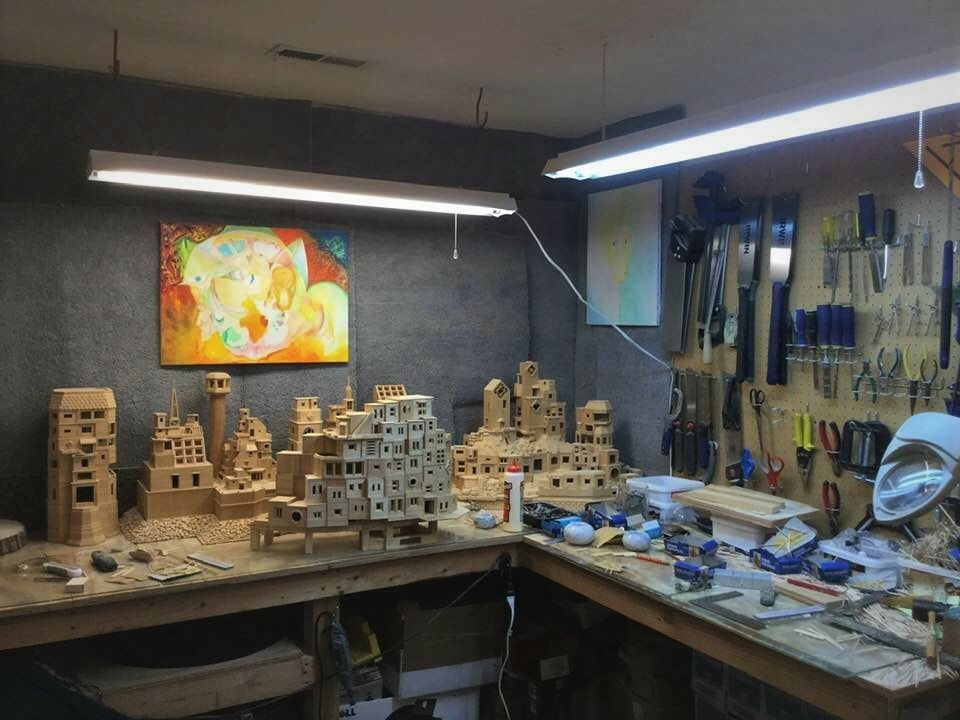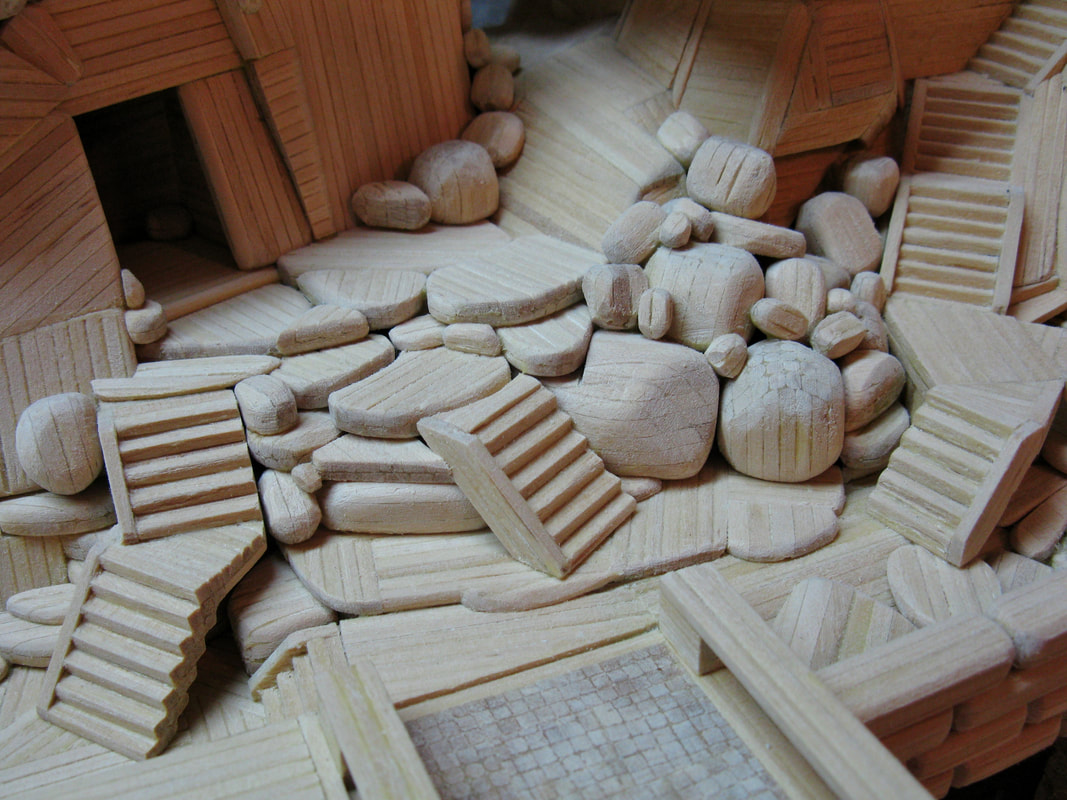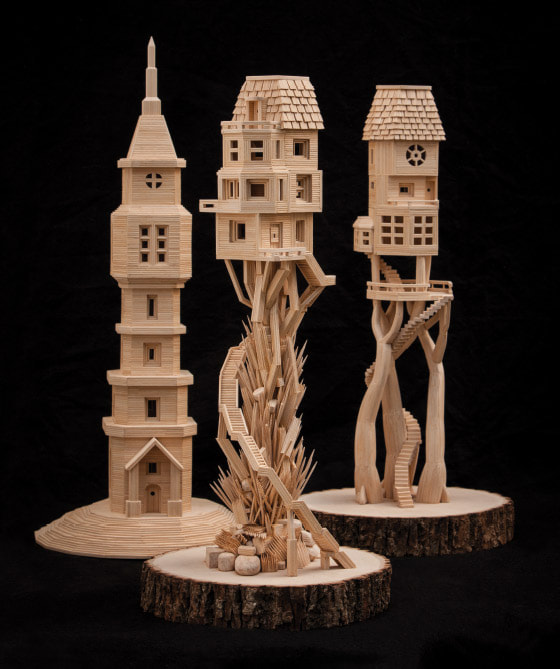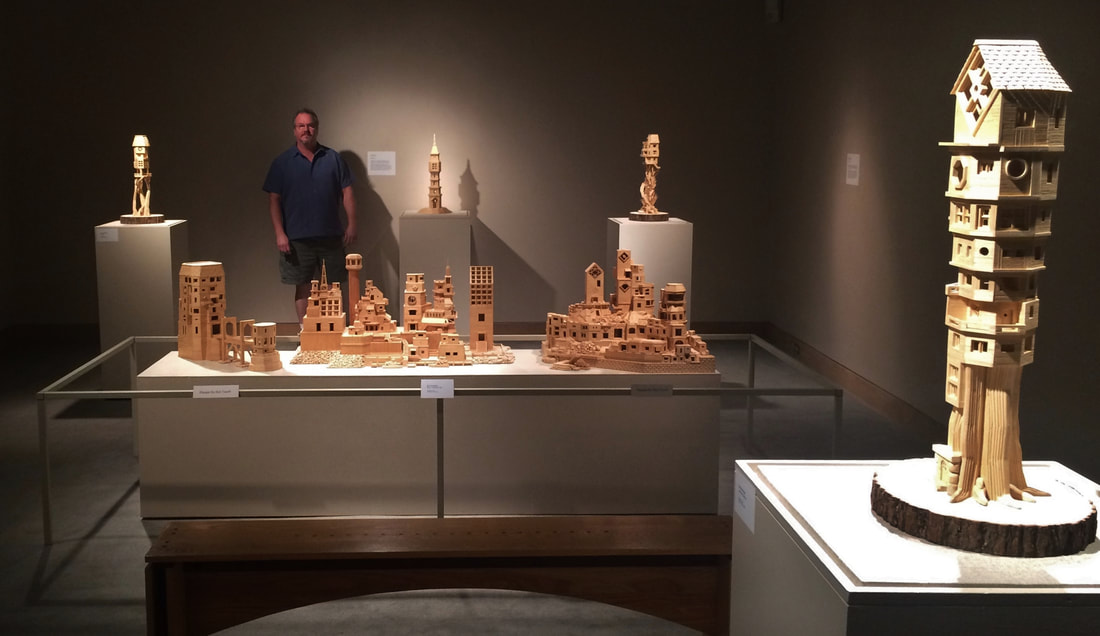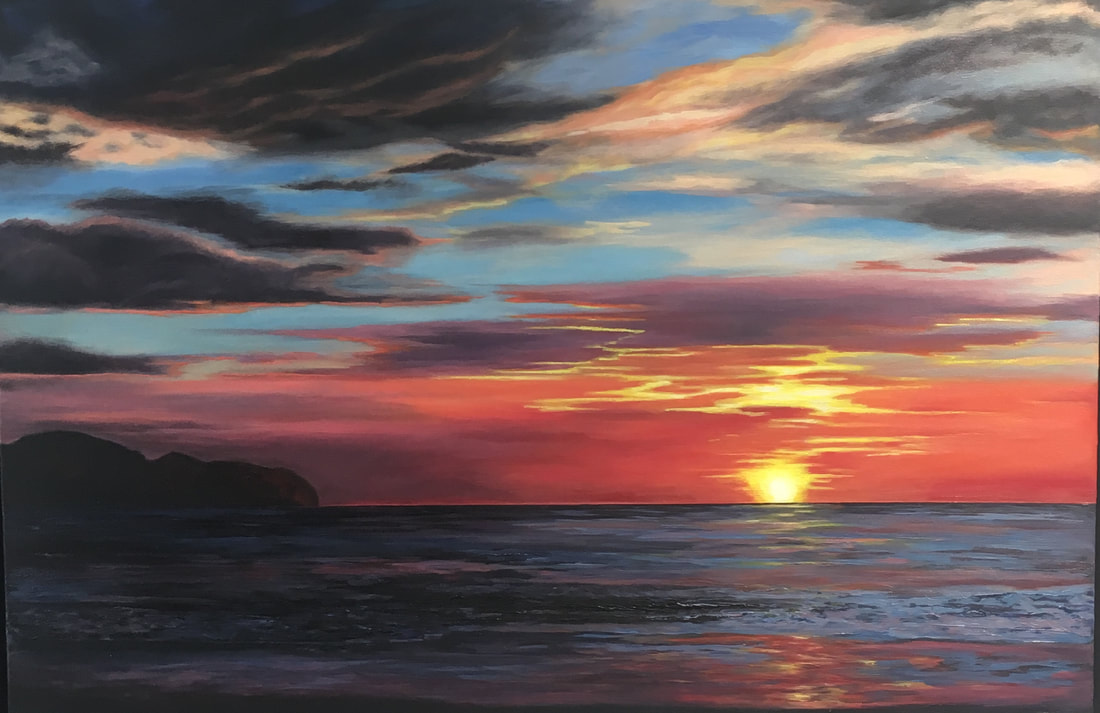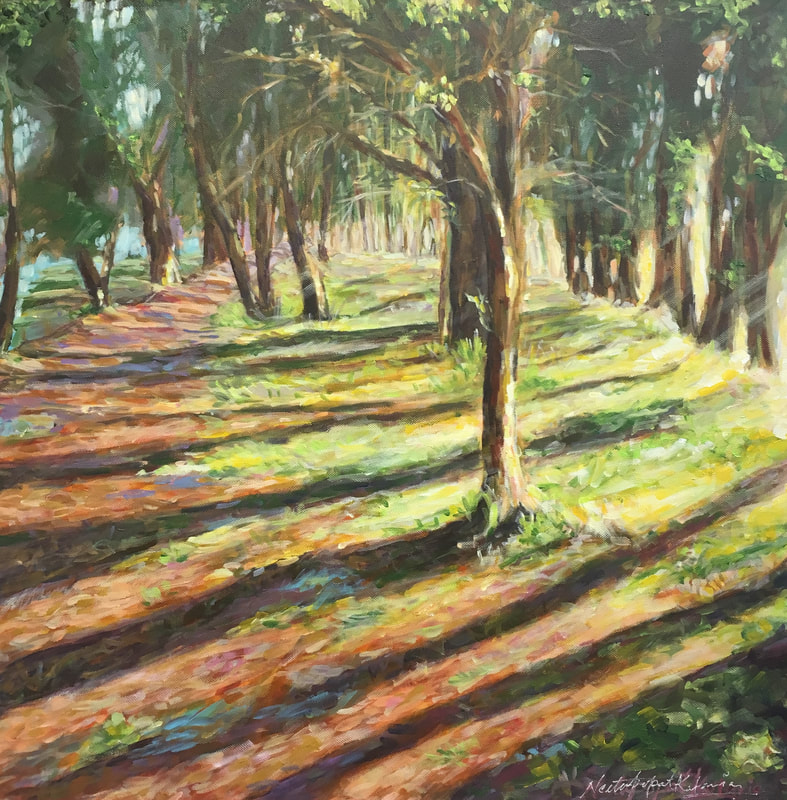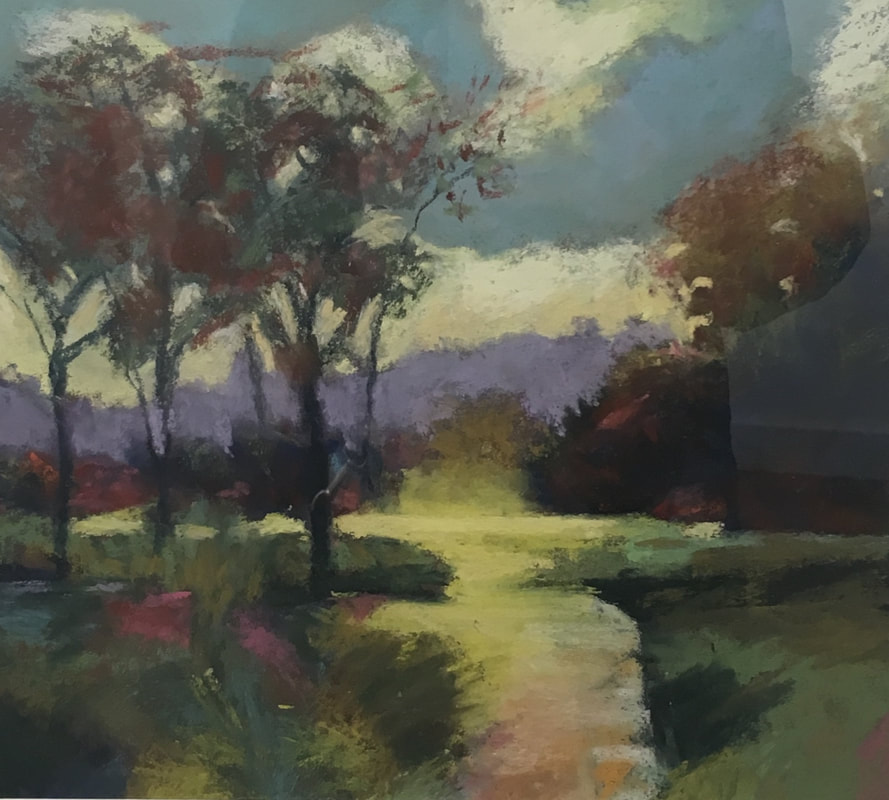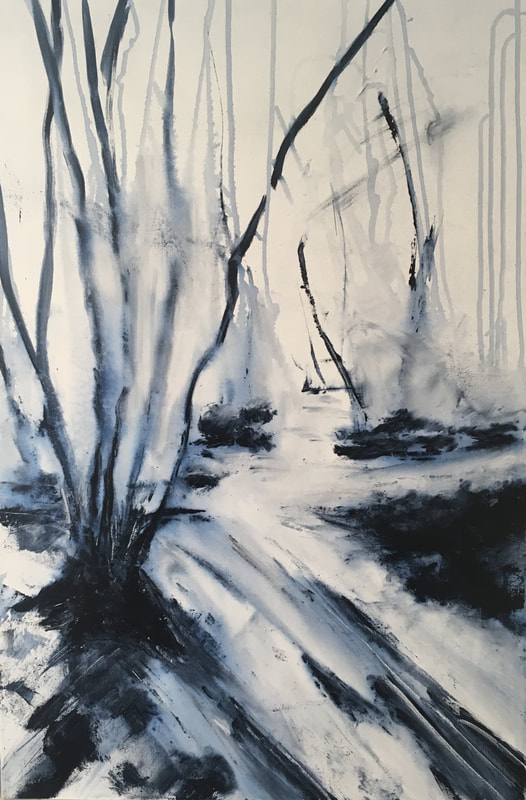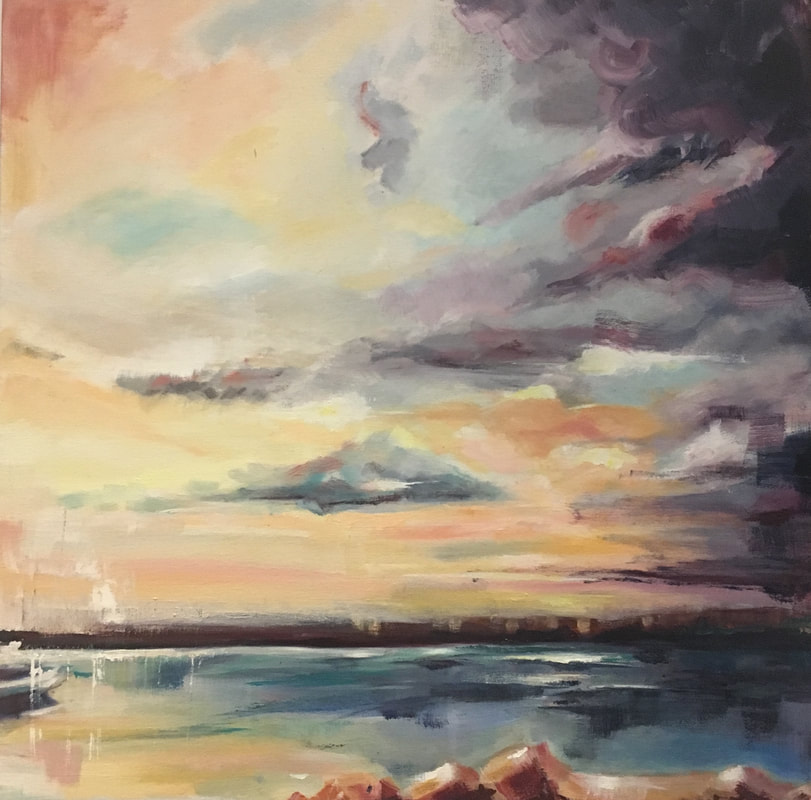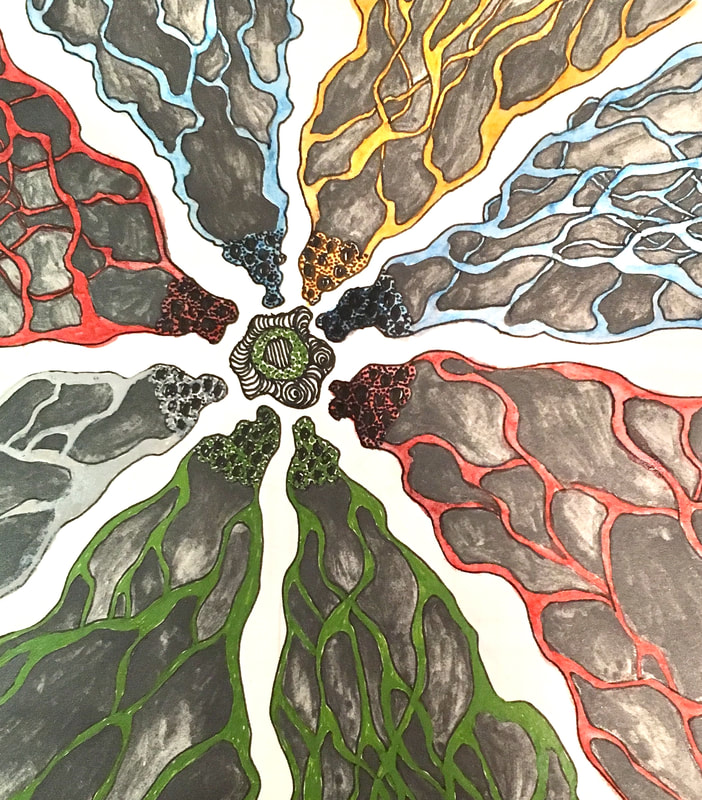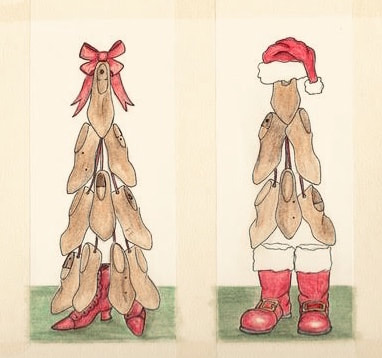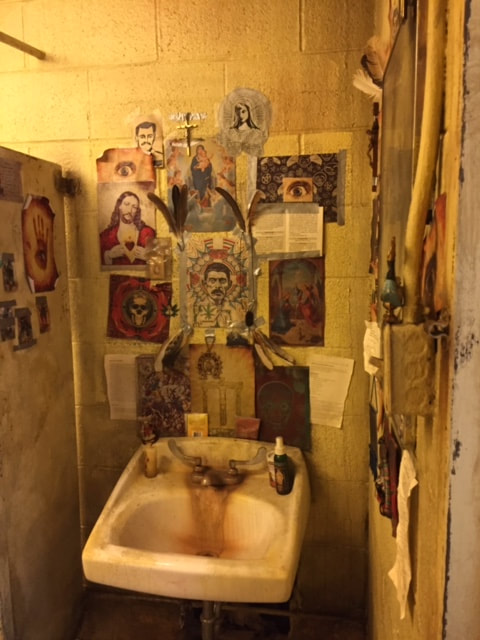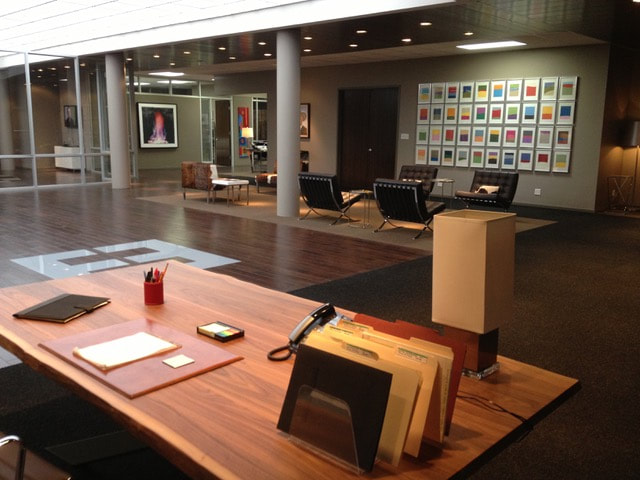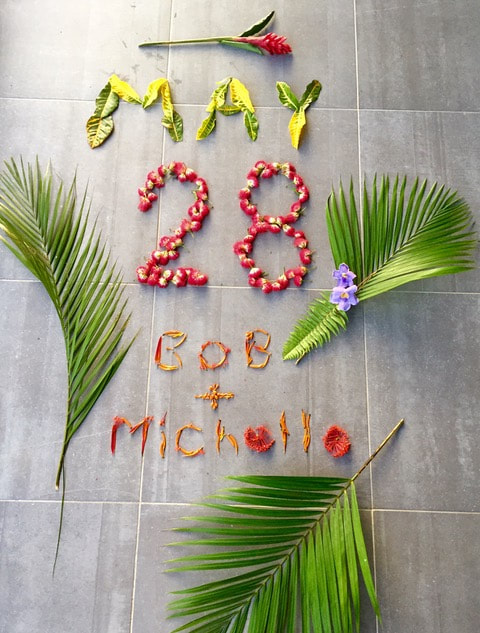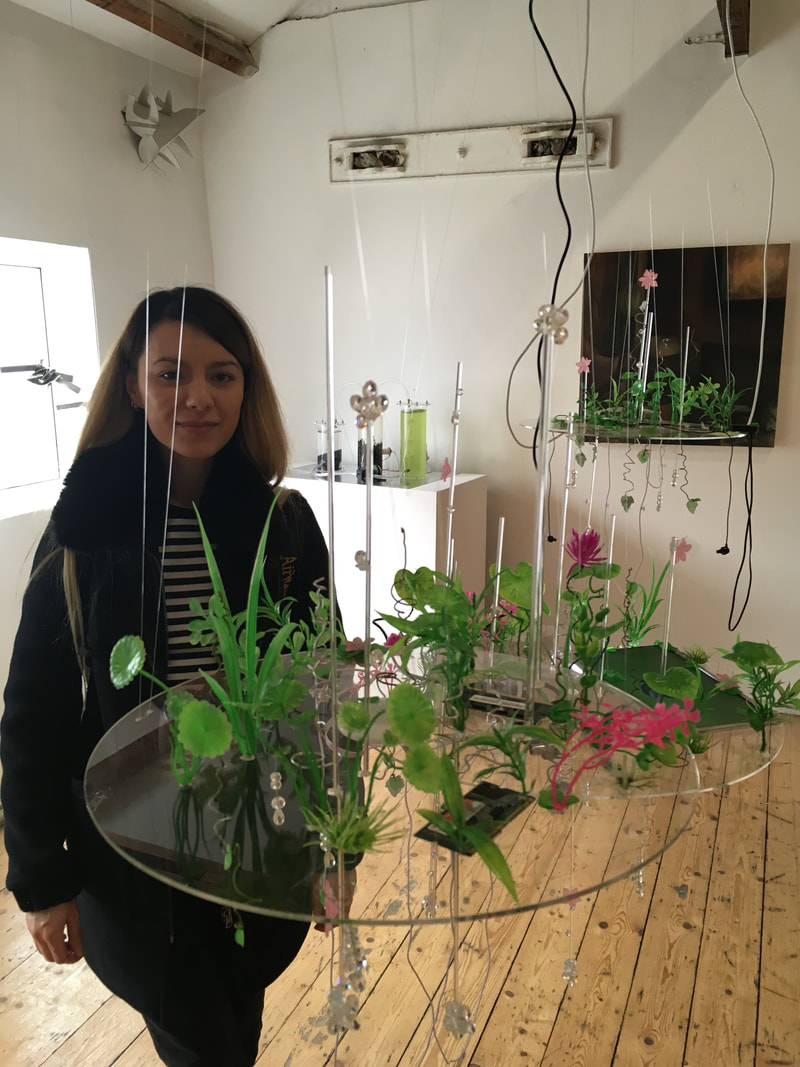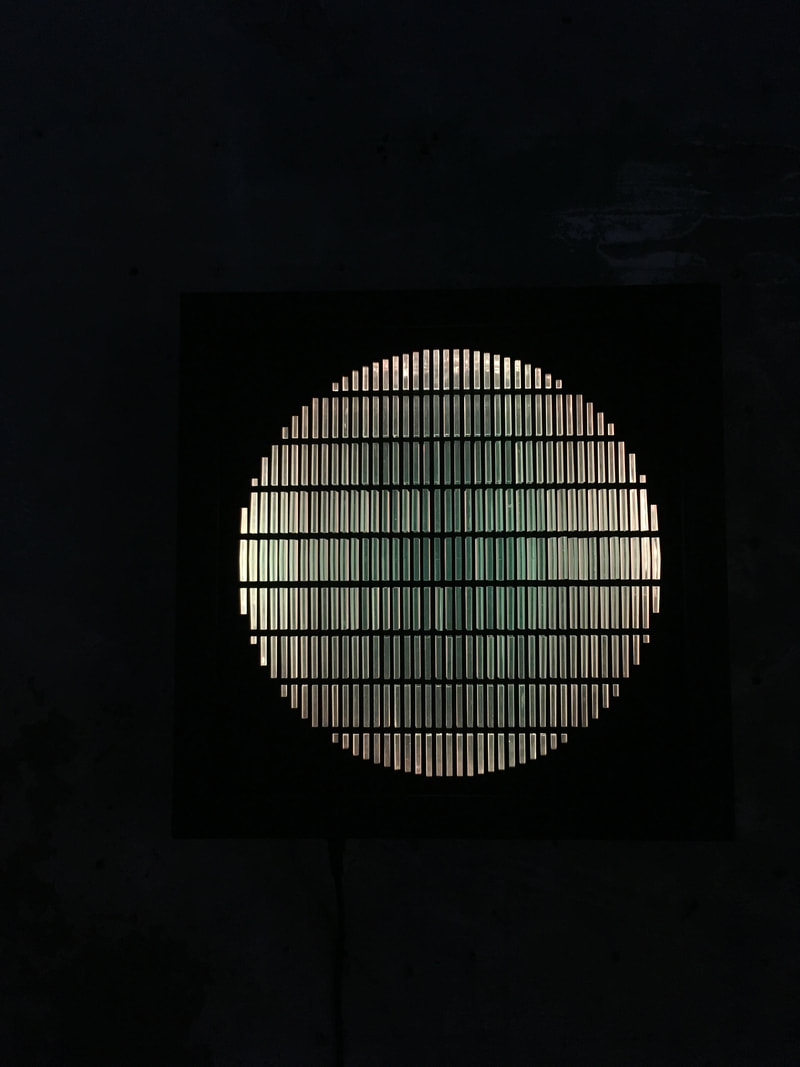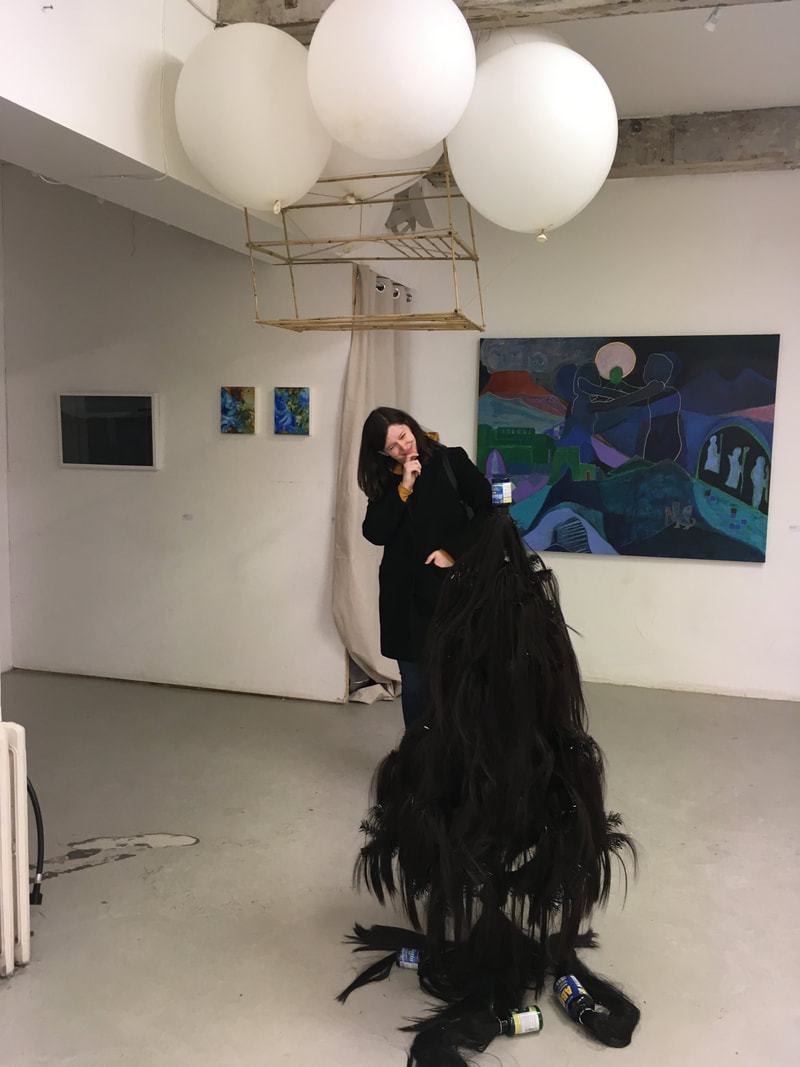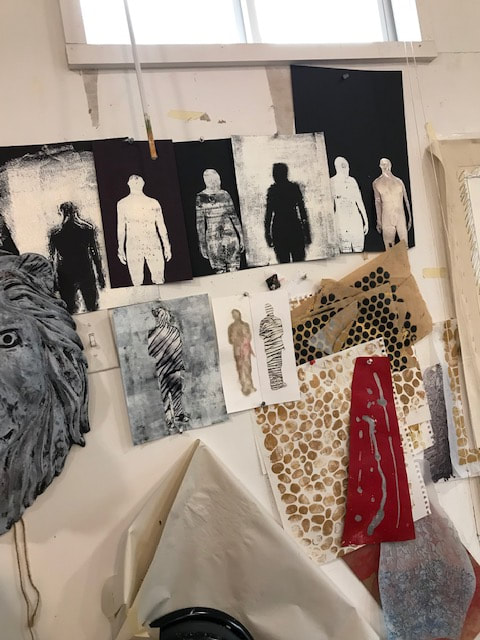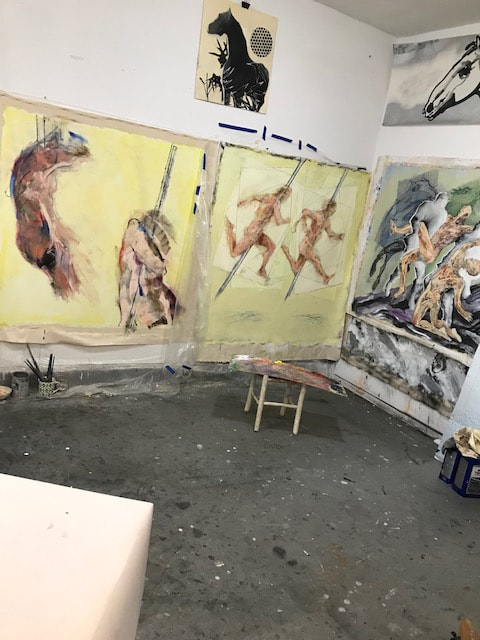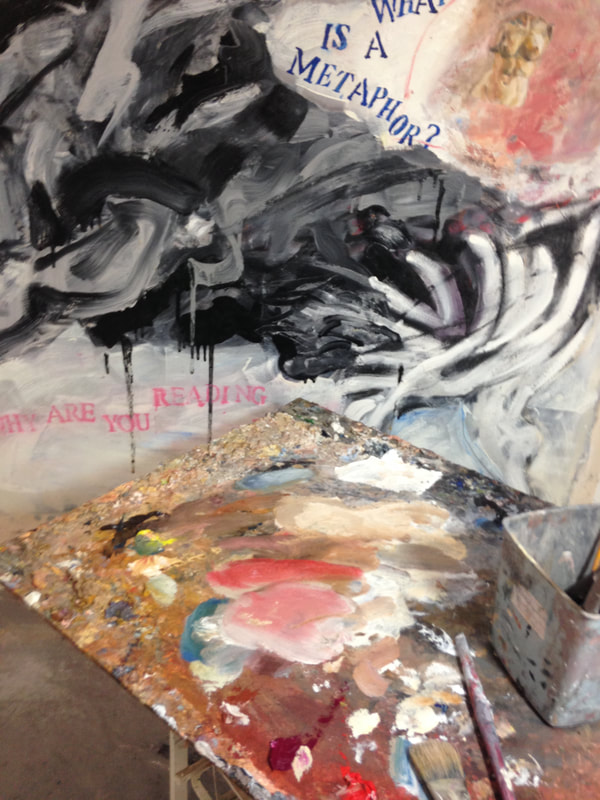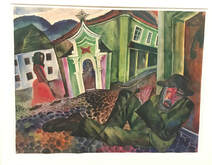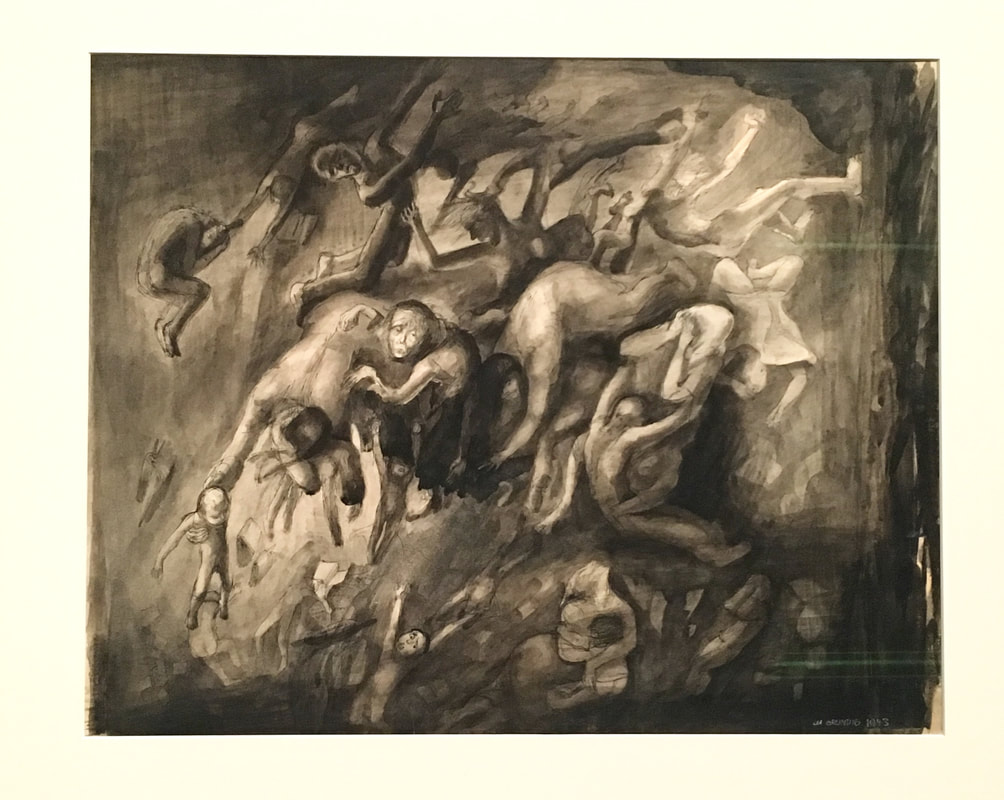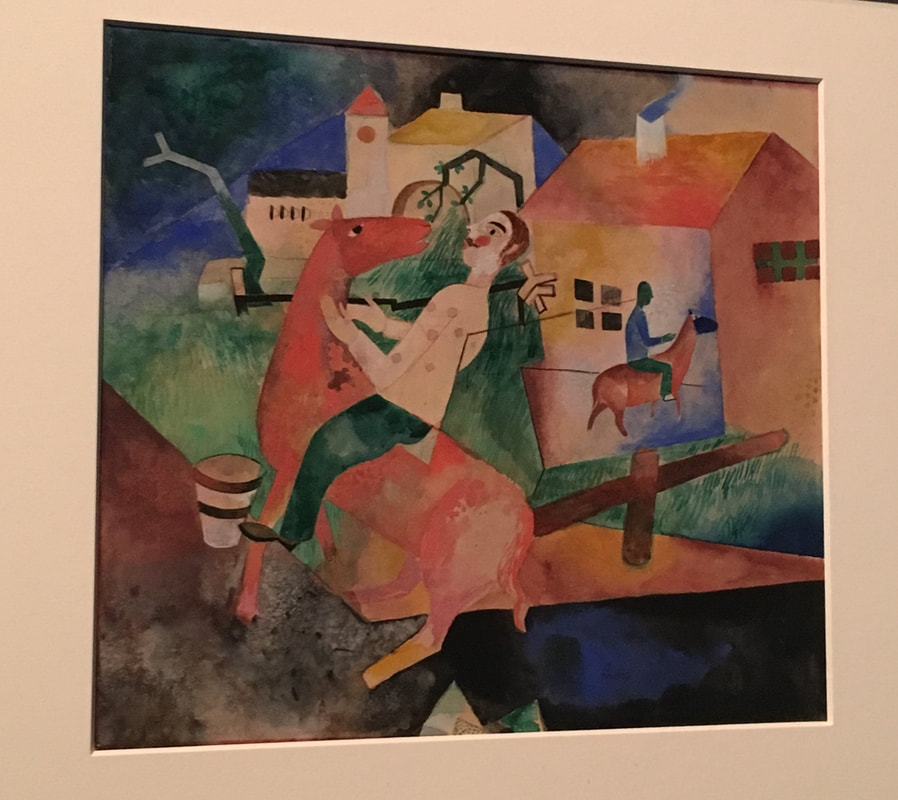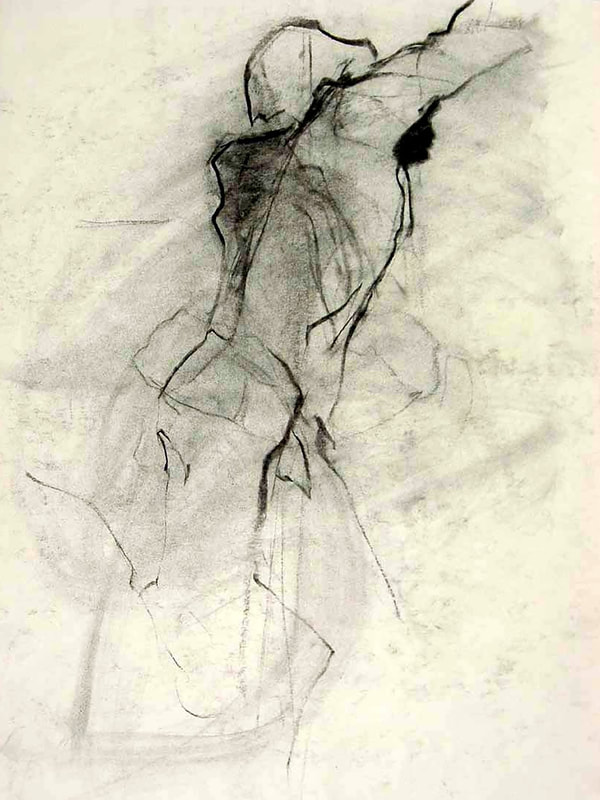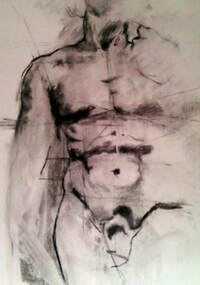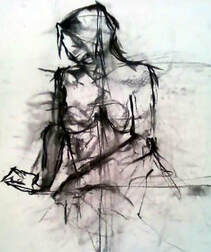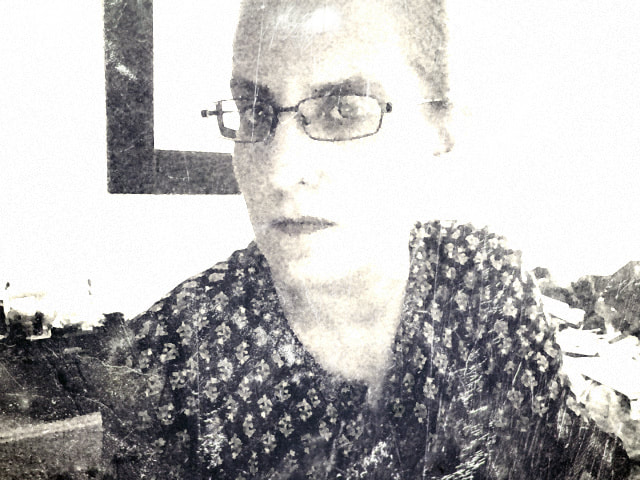|
I have an addiction to drawing complicated repetitive patterns of tangled tree branches in pen and ink and hiding various words or images or my signature within these branches just for the fun of it so I had to write about this addiction!
I've made a speed video so you can see how very addictive my ink pattern drawings are! If my fingers were able to go on drawing for hours without sleep then this is the activity I'd probably choose! I find that the best pens to use for my addiction are Graphik Line Maker pens, Faber-Castell PITT artist pens or Staedtler pigment liners.....all varying sizes. If you want some of those pens for yourself then just click on the highlighted brand names so you can purchase your own on Amazon. I tend to go through one of each size in about a month due to my addiction! I find this type of drawing very meditative and very similar to how I sculpt in toothpicks so I think that has something to do with the addiction as I'm just as addicted to creating toothpick sculptures as I am to drawing! I love the stark contrast of white paper against thin black lines as it feels to me as if the lines are like a visual vibration and very pleasing because I unconsciously try to find shapes or words in these branches which is probably what has lead me to hide words, shapes and my signature in my drawings. I love the idea that the viewer has to interact with my drawings rather than just passively look at the thing.....more fun to play a game, don't you think! If you want to try to spot hidden words or my signature in the finished image, make sure to follow me on Instagram to see the finished drawing at the end of this week: @MirMarnia *If you enjoy these material reviews/techniques then please stay tuned every Monday at 9am for more! I'd like to introduce you to a really interesting sculptor friend of mine, who also uses toothpicks to build with! Bob and I came into contact because of our mutual love for creating sculptures with toothpicks so I've been really eager to interview him about his work since the subject is beyond fascinating for me! The way he creates his little buildings and rocks and terrain in his work will just blow your mind as he can do wonders with the very ordinary toothpick! I often wish I could shrink myself down to be very tiny so I could explore his creations as they're so gorgeous and so imaginative!
As per most of my artist interviews, I sent Bob a series of questions which for me was quite a challenge as I have soooooo many questions that I had to really edit them down or he'd have received a very long list from me as I'm far too curious about his sculpting methods especially in a subject area that I adore! So anyway please enjoy below my interview with Bob and then see below for all the links so you too can follow and stay up to date with everything he is creating: Franceska: What first got you started building in toothpicks? Bob: About 40 years ago, I visited the Ripley’s Believe It Or Not museum in St. Augustine, Florida. There were several toothpick and matchstick sculptures on display including, various musical instruments, a Model A Ford truck, and replicas of the Eiffel Tower and Tower Bridge in London, England. I was very intrigued by these pieces and thought to myself, I can do this. Not long after that visit I started creating small toothpick buildings. Franceska: When you were growing up, what types of creative projects did you enjoy working on? Bob: I really liked to draw and paint pictures, still do. Also, I loved to build tree forts. Sometimes I would take them apart and start over with a better design. Music is another creative outlet I truly enjoyed. I started playing drums when I was 12. Franceska: Has there been anyone in your life who has been a big inspiration to you? Bob: Yes, my wife. She has been my number one fan, motivator, supporter and source of inspiration since we met as teenagers. Franceska: What were your early sculptures like and how do they differ from what you do now? Bob: My first pieces were very small and didn’t have a lot of details. Most were like the tree forts mentioned above. Over time, I started developing techniques that helped me manipulate the toothpicks in different ways. These techniques have allowed me to become more detail oriented in my creations. Franceska: Tell me what you love about toothpicks? Bob: You can create with them really quickly. Hahaha, I wish. One of the things that’s cool is using toothpicks not only as a medium, but also as tiny tools. They are perfect for applying and cleaning off glue. Franceska: How do you come up with your sculpture ideas now? Bob: Sometimes I’ll have a dream about an idea and jump out of bed to start working on it, or at least make a quick sketch so I don’t forget. Other times I’ll start by making a window or door, or just an abstract little piece, and just keep adding to it. I like to let the sculptures “build themselves” you know, coming up with new ideas as you create. I don’t sit down and draw a complete blueprint first. I also don’t enjoy making replicas. I love to just use my imagination for my pieces. Franceska: Describe to me what a typical "Day in the Life of Bob" is like? Bob: Get up and grab a diet Mt. Dew, I don’t like coffee, go in my studio, turn on the radio and get to work. Monday thru Friday I usually create about 5 to 10 hours a day. I try to get in a little work on weekends, but life is not all about toothpicks. hahaha. Also, being a musician, most gigs are on weekends. Franceska: Where do you get your toothpicks from and do you have a preference? Bob: I buy toothpicks in bulk from an online site. I usually order 2-4 cases at a time. Each case has 24 boxes of 800 count round/square center toothpicks. They are from Royal brand, but I’ve used Foster, Diamond and other brands in the past. While I mostly use round/square center toothpicks, I also use regular round and flat for certain applications. Franceska: Have you had any big failures in finding your style and have you found good solutions to past problems? Bob: Like most artists, I have some projects that just don’t have the right flow. So, either they sit around collecting dust or I change the direction. I wouldn’t say I’ve had any big failures finding my style, it’s just evolved for many years through trial and error. Franceska: What do you enjoy the most out of what you do now? Bob: Not only do I love to create through art and music, I must create. Creating is like oxygen for me, I need it to live. Franceska: Who is your biggest influence in your life right now? How does your life experience feed into your art? Bob: I was born in Naples, Italy and all the beautiful seaside towns throughout the country seem to be seared in my head. That’s the only explanation I can think of as to where most of my architectural ideas come from. Franceska: What are your hopes and dreams for your art practice now? Bob: I hope to continue to have opportunities to share my work through interviews like this, magazine articles, exhibitions, etc. Having my art out there for the world to see the past 5-6 years has been a dream come true. I’m very thankful...and lucky. Franceska: Are you working on anything exciting at the moment and can you share a little bit about it? Bob: I have a few projects I’m currently working on, but the most exciting one is, I’m working on a new section of my largest sculpture, Bob’s Toothpick City. When this phase is complete, the total toothpick count will be close to half a million. It will be approximately 10 feet wide, 2 feet tall and 2 feet deep. I hope to have it finished in a year or so. Franceska: Thank you so much, Bob for letting me delve into your world and for answering my questions about your work and lifestyle as an artist! I feel so inspired by your answers and I want to publish this and immediately get back to studio to get on with my toothpick sculptures too! I feel like I related to so well of what you have said and I'm so pleased you were willing to share! To keep up to date on all of Bob's work then please follow these links: www.bobstoothpickcity.com www.facebook.com/bobs.toothpickcity www.instagram.com/bobs_toothpick_city_art *If you really enjoyed this artist interview and would like to see more like this then stay tuned every Friday at 9am (UK time) for more really interesting artist interviews! Last weekend, I attended an exhibition with friends at the Camden Image Gallery which turned out to be a fascinating and inspiring visit as I got to meet several of the artists which I found really interesting as well as friends of the artists too. The work is gorgeous and literally a treat for the eyes especially to those of us who love to paint! The painters are united by colour and light and had me returning in thought to my recent visit to the Pierre Bonnard exhibition at the Tate Modern and his explorations into colour and light. The exhibition at the Camden Image Gallery ran from the 13th of March to the 18th of March and featured the work of five artists: Karin Friedli, Ayse McGowan, Dawn Limbert, Neeta Popat Kataria and Diana Sandetskaya. I'm including below a sample of these artists work or at least my favourites of their work from this recent exhibition. I do love how they all have captured nature in such a way to suggest paths not yet discovered or glimpses into a future world not yet explored. It sparked my imagination for sure so I was excited to share what I saw. The red highlighted names above lead directly to their individual websites. Please see below their wonderful paintings and check out each artist and their links to follow what they're up to. Links to all artists and this particular gallery are below the images. "Pacific Sunset" by Diana Sandetskaya www.dianasandetskaya.com www.artfinder.com/diana-sandetskaya diana.sandetskaya@yahoo.co.uk "Evening Shadows" by Neeta Popat Kataria www.neetakpopatkataria.com @nkat27 neetakpopatkataria@gmail.com "Follow the Path" by Dawn Limbert www.dawnlimbert.com Instagram: @dawnlimbert Facebook: Dawn Limbert Art dawnlimbert@btinternet.com "North Cyprus Sunset" by Ayse McGowan
www.aysemcgowan.com ayse.mcgowan@gmail.com Instagram/aysemcgowan_art --------------- To learn more about exhibitions offered by the Camden Image Gallery please go to their website at: www.camden-image-gallery.co.uk If interested in purchasing artwork from these particular artists, then please see below each of their paintings for their contact information. *If you are enjoying these exhibition reviews then stay tuned every Thursday at 9am (UK time) for more from the London art scene. Today I'm reviewing and demonstrating the watercolour graphite that comes in a tin, called "Art Graf". Above on the left you will see a speed drawing video of myself using the material with a brush and then on the right the finished drawing.
One thing to note for anyone who hasn't tried this material yet - I found it easier to first put a few drops of water in the lid of the tin first and then dab the brush into the solid graphite before painting with it. Only reason being that if you put any water directly on the solid graphite cake in the tin then it just soaks away very fast. It's a fun way to add graphite in a fluid way to a drawing/painting but if you want to erase areas of this watercolour graphite then you may be frustrated as it doesn't erase very well. I just painted over the problem areas using watercolour paint and it solved my issues right away. It is lovely and fluid when you paint it on but it dries fast which is a little frustrating as you can never get the perfect consistency because it always dries up after a few strokes. I do enjoy how it can be layered onto a surface and then possibly scraped off with sandpaper (very fine sandpaper though). I'm still not very sure how to use it so I think this is very much something I'll have to experiment with and then return to in a later post once I've worked out how it will work best for me. It is far more fun than pencils but with less control! All in all, I think it's well worth it as a great drawing tool and painting tool for artists and I will plan to repost in the future after I've had some more time to play with it. In the meantime, do have a look at my speed drawing video and let me know what your thoughts are especially if you have experience using this material as I'd be very curious to know other's opinions on the topic. To buy your own Art Graf please click on this sentence to purchase it from Amazon. *If you would like hear more materials reviews and watch more speed video's and demonstrations then do check back every Monday 9am UK time for regular material review posts. I wanted to interview my wonderful friend, Michelle Young-Wilson, as my next artist interview but because she has kept me inspired by how she leads a creative lifestyle. Also I wanted to offer this celebration of my lovely friend this week as this is the week of her birthday which works out perfectly! Michelle isn’t a practicing artist but her way of living, her daily activities, our exciting adventures together, how she cooks, her recipes, and her creative projects have kept me smiling and bright inside for several years already!
Michelle is one of the few friends who I can be silly with or have spontaneous adventures that seem outrageous but so much fun; or create imaginary worlds with just sticks and leaves! I have such fond memories of so many types of adventures we’ve already had and its rather exciting to think of the adventures yet to come! So today is an interview with a creative in the way she lives her life and perhaps some moments into our adventures together! Franceska: Do you have a morning routine before you start your day? Michelle: Yes. Because I have a dog, I do. Otherwise, I’ve never had much of a routine and I have trouble doing anything consistently. I rather invite change and transformation…I think I like the stimulus. My morning routine, at the moment, is all about my dog, Hawkeye. He wakes me up at dawn and we go for a walk and I have come to love our walks together. I really get to observe the seasons change. I see the first flower buds and leaves on the trees in spring and get to watch the leaves explode into color in the autumn. Hawkeye is always living in the present moment and he is constantly reminding me to return my focus to the present. I love him for that. After our walk, it’s time to make breakfast for him and myself and sometimes, my husband, Bob. Breakfast has become its own sort of meditation. I think I love cooking because it keeps my focus and attention from start to finish and since breakfast comes together quickly, it is almost a fluid dance. Just think about it: biscuits in the oven, bacon frying, tea kettle whistling, eggs scrambling and you are working for it to all be completed at the same time hot and delicious! With the right perspective even something as mundane as making breakfast can be artful. After breakfast and cleaning up, my day is entirely random. I get my work done as early as I can because that’s when I have the most energy and focus. I am always wanting to add yoga to my morning routine, but it just hasn’t fit in, yet. Franceska: When you were young, how did you use your imagination in play? Michelle: I remember playing alone a lot in my room. I liked setting up scenes with my dolls. I would make sofas from Kleenex boxes and little cakes from York peppermint patties. I made a circus trapeze once for a Barbie doll out of straws, string and scotch tape. Then when she fell from the trapeze, I made her crutches from straws and a cast from toilet paper and scotch tape. Something funny I remember, is that I set the scene as if to take a picture of them, I never was good at coming up with any dialogue. When I was playing with my older brothers, I was just trying to keep up and be tough. We did things like set firecrackers off under our GI Joe’s. It seems like the boys were always playing at war or car racing and I was always wanting to make something pretty. Franceska: When you cook, do you have a plan or do you prefer to experiment? What have been the best experiments? Michelle: It depends on who I am cooking for. If it’s just me, it’s an experiment. I may use a recipe for inspiration but I change it to use the ingredients I have on hand. But if I’m cooking for someone else’s pleasure, I take it much more seriously and strive for perfection. I recently made Christina Tosi’s (of Momofuku’s Milk Bar fame) Strawberry Lemon Cake for a friend’s 70th birthday. It is the most complex cake I have ever made. It has 6 elements that you must make separately and then you assemble it and freeze it for 12 hours to set. It was worth it! Absolutely delicious and everyone who had a slice agreed. If I ever make it again, however, I’ll do it as a trifle and not freeze it at all. Franceska: In your work, how were you able to use your own creativity and was it often a challenge? Michelle: I worked in the Art department in the Film and Television Industry for 14 years. I am truly grateful to have been able to use my creativity everyday in my career. When I interviewed a new potential employee I would tell them that being a creative problem solver was one of the most important qualities for any film-maker. And even though, I have moved on from that industry, I still use my creativity daily. Creativity can be utilized in all things. A mechanic can be creative about the way he repairs an engine. I think challenge breeds creativity. Isn’t all work a challenge? That’s why we have this love/hate relationship with work. We want the stimulus but we resist the challenges. I believe we need challenges to grow and advance and become. Using creativity to overcome challenges is part of human nature. My dad, really inspires me in this respect. He is a creative problem solver, I learned so much from just being around him. If we had dropped something down a drain, for example, and couldn’t get to it, he would craft some device out of whatever was around to retrieve it for us and he loved doing it. He instilled in me a sort of confidence, that no matter what, we can figure this out. Franceska: Are there any books you read growing up that you feel made an impact on who you are today? Michelle: Absolutely, yes! There are so many books that I read in junior high school specifically that I believe shaped my moral character. Julie of the Wolves, Island of the Blue Dolphins, The Witch of Blackbird Pond and Roll of Thunder, Hear My Cry are the first that come to mind, though I am sure that there are more. Franceska: Do you have any creative projects you have done in the past that you really enjoyed? Michelle: I’ll be like Jesus and answer your question with a question: Are there any creative projects I have done in the past that I didn’t enjoy? Even the hardest creative projects I have worked on, the ones that felt like a huge pain in the ass when I was working on them…looking back it all seems like great fun. Franceska: What inspires you right now in your life? Michelle: My focus for the last few years has been on the spiritual and mystical realm. I light up when pondering our infinite and essential nature. There is so much to explore and nothing is concrete, which delights me to no end. In a more tangible respect, I find a lot of inspiration in cooking. I am at home in the kitchen. The process of creating with food pleases me because I always finish (unlike many of my paintings and drawings) and once it’s eaten it’s gone….clean slate for tomorrow. Franceska: What is your favourite colour and has it changed over the years? Michelle: I love them all and I can’t pick just one and why should anyone ever have to? I am intrigued by birds because they have more color cones in there retina and can see a range of colors that humans can’t see. Isn’t that exciting. The idea of new never-before-seen colors! Franceska: Do you have a favourite dessert and if so has this changed over the years? Michelle: Oh, Franceska! I’m really not good at picking favorites. I struggle to think of a dessert I don’t like. If I have something sweet, I want it to be well worth the calories. I would choose buttery breakfast pastry over a cupcake. I don’t like things that are sickly sweet, I often go for something that has a hit of tartness to balance sweetness which is why I enjoy fruit in my desserts. But then there’s chocolate and who could pass up a good slice of chocolate cake? Not me. The choice is impossible. Absolutely impossible! Franceska: What are your hopes for your future? Michelle: I am a person who works hard at being present, but I do think that daydreaming and visualizing is a good tool to use when creating the future you want. I recently made a vision board for not only my current human existence, but also, for my next transformation. For my next life, I would like to be a Beautiful Bridge Builder who makes breathtaking bridges between planets and galaxies with her wand that works much like a 3D printer. (and I can fly effortlessly) How’s that for hopes for the future?! Franceska: Oh my goodness! I've read through your answers with wonder, agreement, laughter and lots of lots of smiling! I know I completely relate to all and so love that you let me interview you during your birthday week about your life! That was lots of fun! Thank you Michelle for sharing! - Please note that any highlighted words in this interview will send you to the items they are talking about. - The images selected above..... top left - "Candy Cobbler & Window Cobbler" sketch by Michelle Young-Wilson for a potential window display; top right - set from the "Dallas" series created by Michelle Young-Wilson with her words about it, "It shows a huge piece of artwork that I created from colored torn paper. Of course i also selected and placed everything else in the photo." bottom left - "Voodoo Bathroom" set from "Queen of the South" TV series with one of the drawings from me, (Franceska McCullough) of Jesus Malverde; Bottom right - "i thought about the Save the Date pic I sent out for the Bob and Michelle wedding. I had run out of time and wanted to do something a little different so I just arranged flowers and leaves that I found in Costa Rica on my walk that morning….it was just plants I found along the road." *If you enjoyed this interview then please follow this blog every Friday 9am UK time for more artist/creatives interviews! My friend, Heather Scott and I just recently had a look around the Interim show for select postgraduate courses at Central Saint Martins here in London. First year students currently in MA Art & Science, MA Photography and MA Fine Art were showcased in a gallery space in East London, called The Apiary.
Both Heather and I first met when we were first years on the Art and Science course so we admittedly were curious as our exhibition experience our first year was quite appalling so we were hoping that this new space would be an improvement! First impressions on arriving were that the venue was indeed a great deal better than what we had experienced so that was definitely a plus! There was excellent lighting, lots of great wall space, real wooden floors and no unusual railings or dusty corners or odd yellow stripes. But as most student shows go, it didn't wow us unfortunately.....both of us felt that it was way too overcrowded.....there were larger artworks that simply dwarfed smaller pieces and caused us to completely overlook some really nice smaller artwork. More white space would have been a benefit as it was such a jumble. The curating of the exhibition didn't create an easy flow to the work and lets not even get started on the labeling! When I was studying my first degree way back in the 1990's, I remember distinctly that my teachers told us how very important it was to make sure that we knew how to properly label our work in an exhibition setting.....this entailed understanding how to make professional labels that had our name, the title of our work, the date it was created and a relevant description and the price. All vital and basic but something the instructors/curators have forgotten to teach at Central Saint Martins. I'd say that I was most attracted to the MA Fine Art students as a select few were making really interesting work and I will definitely follow them to see what they come up with in their second and final years. One first year in particular was a lady named, Sian Fan who was luckily standing right by her really interesting work when we were trying to understand which label was hers. Sian is an MA Fine Art first year and had such an unusual piece that was suspended from the wooden rafters. I was drawn to her work the moment I walked in the room.....we had a short conversation and were intrigued by her explanation of her work. The fact that it's suspended in the centre of the room and lets light pass through it while also catching and holding light and sound was just fascinating......she explained to us about it being something like a realm in another world.....I'm not doing it justice and I'm eager to talk to her more about her work and hopefully interview her too for my blog. I wish her work had been away from all the other pieces in the room as they overwhelmed it. The image above on the top left is Sian and her work......I found her work very ethereal and I'm intrigued to watch her progress. So keep your eyes out for this artist - Sian Fan! MA Art & Science did not spark any interest in this show sadly......or at least, if there had been labels helping us identify who belonged to what and what it was all about then that could have changed our opinions a bit. I left with a feeling that MA Fine Art are the ones to watch out for.......though only a select few. As for MA Photography which is apparently called something else now.....left us clueless because again......ineffective labels. So well, keep your eyes peeled for Sian Fan (click on her name to reach her website) as she's really creating something exciting! I'd love to tell you to watch for the artist who did the glowing glass thing in the middle photo above but I couldn't find the label! Heather is posing in the photo on the top right because we were utterly confused by the pile of hair and the hanging balloons and sticks.....because again....ineffective labels. We were told on arriving that there would be a tour going through to explain artworks to a visiting group but we didn't join in as we were already half way through the exhibition by that point and on a limited schedule. To check out my friend Heather Scott and her creative process as a graphic designer please follow these links: www.graphicdesignhs.co.uk and www.facebook.com/graphicdesignHS *If you'd like to read more exhibition reviews then please stay tuned every Thursday at 9am UK time for more. Lack of motivation can hit at any time in a creative process.....for me it's usually when I've got a deadline to complete a project which is the worst time. So in an effort to get myself back on track I have a few techniques I try which do always seem to work if I'm patient with myself.
Firstly, I allow myself to make a mess no matter what my ultimate objective is. The goal here is to let the mess happen without restricting myself to using the materials for whatever it is that I'm avoiding working on. I find that if I allow myself to just play then the images and the ability I'm blocking will return but gently and without me pushing myself. If however that fails and frustration occurs......(example: noisy flatmates who make so much noise that it's impossible to focus even in another room) then I plug myself into music or anything that helps me concentrate and block out the distractions. Creating speed videos of making a mess with no ultimate outcome is always quite cathartic somehow as I do enjoy watching to see how images emerge out of a mess and then this itself gets me motivated to try again, this time usually with an idea in mind which means I'm on the right track to getting myself really motivated! Lastly, rewards help.....I make a list of the most simple tasks and take absolute delight in ticking them off once I complete them and a reward always helps too so if I have something in mind as something I can really enjoy if I accomplish all the tasks on my list then I have motivation to keep going. What often happens is that I get so caught up in finishing the tasks that I can become caught up in the creative process and end up going back to it even after my reward which is a bonus! My favourite material in which to make a mess is ink.....in bottles and all vibrant. If I just start dropping dollops of brightly coloured ink onto a wet or dry surface and moving it around with the ends of paint brushes and then going back to dab and then draw into it.....I can make a serious mess but eventually it'll become something and this something is the spark to keep going. The video you see above is my attempt to motivate myself today.....you can see it started out as unrelated marks and nothing more and then eventually became an old tree! But now, I had so much fun that I want to try again and I'm brimming with ideas and my elusive motivation has returned! *I'd love to know what other artists do to recharge their motivation and what techniques they employ to get it going again.....I do hope someone feels like commenting as I'm very curious! **If you'd like to keep following Materials posts then please stay tuned every Monday at 9am UK time for more. Following last Friday's interview with my artist mother, Juliette McCullough please find below the 2nd part of the interview which I think is even more fascinating than last week! Having grown up with my mothers artwork all my life and heard so many accounts of her life as a young artist, I thought I'd learned it all but in taking time to further delve into her work and life as an artist it has given me so much more which is so very inspiring indeed!
I would encourage you to check out Juliette McCullough's website (listed below) and also follow her regular Instagram updates. She will inspire you guaranteed! Here is part 2 of the interview. Enjoy: Franceska: After finishing your studies, were you able to set up an art practice? What were your challenges at that time as a newly qualified artist? Juliette: It was so very challenging to find myself facing only myself without any controlling incoming influences. It was terrifying, especially because I wanted to paint human beings, but had no models. That was when I first started pulling images out of my boots so to speak. Because I had worked so much from life I was really surprised to find that I could create from memory which opened up so many possibilities. Suddenly moving (painting or drawing) across an empty surface became a journey in which the image came through me, in spite of me. It was, and still, when I am lucky, continues to be like dreaming while awake (a lot like the ‘Active Imagination’ practiced by Jungians. I had to submit to what the image wanted, and so each attempt became a sort of dialogue, a real push/pull between me and the surface. While the process itself was a deep experience, the resulting outcomes never satisfied me at that time. I don’t think I had any real identity until I faced and came through that difficult lonely struggle. It was all intensified because I changed countries at the same time, so I left behind everything and everyone who knew me, everyone whom I could relate to artistically. I became an unrecognizable stranger in a new land, and a foreign culture. This was before the internet and everything that connects us globally today. I read a lot, and looked to artists I admired for some inkling of how I could develop. I remember coming to the shocking realization that artists in previous generations had had a mythology to live by, even Picasso was born into a time when I think ‘myth’ and an imaginal world was still alive. I found myself struggling to give form to my most nonverbal ideas in the dead years of the end of the 20th century. I was hit by our collective loss of meaning through our reduction of ‘myth’ to mere fairy tale insignificance. Nietzsche’s idea of ‘the death of god’ seemed right on to me. It was only then that I was able to come to the conclusion that a ‘death’ would precede a ‘birth’, that the death of an old order was in fact the beginning of a new one! So, as a young artist I decided that my only hope was to follow my own nose and my own instincts in spite of the fashions of the day; to find my own personal mythology. This was before I came upon the works of Carl Jung and his idea of ‘archetypes’. I have been learning from him and his ideas for many years now, and the journey still helps me understand my personal struggles in relation to the collective, and it all relates to my artistic journey. Franceska: How does your art practice now differ from your early years after your education? Juliette: I haven’t had time to practice properly since I was in art school. Working to keep a roof over my head (especially as an immigrant). This is why young artists today go for ‘fame’ when they are at the beginning of their journeys, because they hope to make enough money to buy the time to be able to practice their craft uninterrupted. I have had to learn to carve time out of my life to get in the studio, and it does affect my output, and my rhythms of working. Having said that, I now have a confidence and better awareness when I do get concentrated time to work. Franceska: What artists had the biggest influence on you as an artist? Juliette: So many really, but some that come to mind immediately are Rembrandt, Picasso and Willem de Kooning Franceska: What is the best studio space you’ve ever had and how did you use the space? Juliette: The one I have now - but then any space I have used has always been the best! I like to stretch my canvases straight on the wall. I like to be able to bash away on a solid surface so that I can push and pull the paint and scrape off too. Then, if an image ever gets to the state that it is ready to go out in the world, I do have the pain of having to stretch it after it’s painted. I have often enjoyed painting on the floor too. I found it necessary to get away from the typical canvas on the easel situation. Franceska: As an artist, have you ever felt the need to react to the political climate? How did you react and how was it received? Juliette: Yes, of course, how can I not be affected by what is going on around me! But, I have never considered myself a political painter. Mostly, those images will come out so strong that I don’t attempt to show them, or doubt that I would find a suitable venue for them. However, I started a series of images in 2016 which became my way of handling the stress of the political situation we were living through, and I was delighted when I got to show one of them in the inaugural exhibition at the Center for Contemporary Political Art in Washington DC just opened by Charles Krause. https://www.politicsartus.org/ Franceska: How did you manage to raise a family and maintain your art practice? How did you keep your focus? Juliette: With difficulty, but I consider painting as a way of living, rather than separate from living. Every experience I have in my life informs my images as it grows my consciousness. Nothing has been easy, but as long as there is a burning need to make images, somehow they will come out. Franceska: If you could go back and give advice to yourself when you were just beginning your art education, what would you say? Juliette: Trust my instincts. Franceska: How do you arrange your palette? Can you describe how your palette has changed throughout the years? Juliette: I think the changes have been small. I used to use a very limited palette using only primaries and a white, and that was a great discipline because I had to really learn to mix. Maurice de Sausmarez who ran the Byam Shaw School taught me how to sensitize my eyes to colour nuance, based on the studies of Johannes Itten and Hans Hoffman at the Bauhaus. I owe everything to Maurice’s intense education in experiencing colour. I added to my palette very slowly and methodically - I remember the exciting day I bought my first tube of cobalt violet! Then learning about the incredible differences between cobalt and ultramarine blue, and cerulean - they are such very different visual energies, and after years of practice my brush (or whatever tool I use) knows exactly where to find the energies I need on the palette. Franceska: Do you have a favourite colour and has this changed over the years? Juliette: Now I just love yellows, paint as much of my house yellow as I can, but that doesn’t mean that this is going to have a huge effect on my painting Franceska: How do you feel about how artists now have to exist in a world of constant online imagery? If you could change anything about how we as artists get our work out there, what would it be? Juliette: Having felt totally isolated in my studio for years, I actually find that the online world can connect me to other painters in a way that has never happened before ! I love to see the work of young and not so young artists in Europe and Asia etc. Seeing the real thing is always far more exciting and revealing, but I will take the world of digital imagery over the poverty of abject isolation, which is often the lot of the pioneering spirits who cannot afford to live in any of the major cities. Even then, so much that is showcased in our cities is more about the response to ‘art as commodity’ which is dominated by a false market driven by the collections of millionaires. I believe this has very little to do with the real creative folk who are speaking with authentic voices and possibly really affecting our world. If we can only manage connection on line, at least we have that! Franceska: Thank you so much for taking the time these last two weeks to answer my questions and letting me dig even further into your life as an artist! I found myself relating to everything and smiling a lot especially at your love of yellows (being that I helped paint your kitchen yellow a few years ago!) I know that other artists of all ages will find inspiration in these interviews! To learn more about the work of Juliette McCullough please go to her website: www.juliettemccullough.com To follow Juliette McCullough on Instagram please go to: @Juliette_McCullough To follow Juliette McCullough on Facebook please go to: @PainterOnTheEdgeOfMystery If you have any questions for Juliette McCullough please do comment on this post and we both will try to answer the best way possible. *If you really enjoy these very inspiring artist interviews then please do follow this blog for artist interviews every Friday at 9am UK time. Very recently I went to see the Magic Realism: Art in Weimar Germany exhibition currently at the Tate Modern. First off, its free to get in so that's a bonus right away for those of us trying to save money in an expensive city!
Secondly, it's so worth a look through as the work is exquisite and the content fascinating especially if you're an artist like myself. I'm fascinated by art history and though I have many favourite areas in art history to which I'm most drawn to, (no pun intended!) but I do find very intriguing, the early part of the twentieth century because it feels to me like it's had the biggest impact on my own art practice. I'm interested in patterns you see, not just in my creative process but in history too and so I find this time period of 1919 to 1933 in Germany most interesting indeed as it does have some echoes into our place in history now for good and bad. Get ready though if you go to this exhibition, some of the work is difficult to look at and there is a room in which a sign has been put up to warn people that there are some disturbing images. I didn't stay long in that room and I didn't take pictures in there either as some images did make me cringe. I will say that when I was in art school in the early 1990s, and in the honeymoon stage of being a painter, I found myself living at the fine art museums and literally drinking in the moody paintings of Max Beckmann, Otto Dix, George Grosz and Max Ernst. I'd then return to my studio and whip out my own moody renditions but without a clear understanding of the history behind why the painters that inspired me painted the way they did. It was only after years of reading and researching that I began to grasp what those artists went through and what they were doing in their own creative processes. Even going through this exhibition at the Tate was eye opening in many ways mostly because I'm at the stage in my life as an adult where I can relate to those artists and what they wanted to express in the world they lived in. I've always been what I call, an "Art Activist" and many times have used my artwork and creative ideas to express how I feel about a political situation that has an impact on my world. My ongoing peace project, "11 Million Hands for 11 Million Lives" is an activist project because it's about fighting for equality between all humans on this planet. I've made it clear in my peace project on multiple occasions that I do not support the little orange president in America as well as the inequality and tension he and other world leaders have brought to our existence. So I can relate completely to the artists making art in the Weimar Republic due to the aftermath of war, the political shifting climate, the economic crisis and the unstable social environment which isn't much different than our own time. The artwork in this exhibition is potent and speaks volumes even a hundred years later! I found myself lingering over certain pieces and trying to imagine what the artist was feeling at the time of making it. Their reactions in pen, paint and pencil to their rocky environment in the aftermath of a devastating world war still rings true today. The impacts of social changes and economic hardships still resonate to what I hear in our news now. The repeating of a pattern in history is a concerning weight and I do wonder how our next few decades will pan out. There's a quote on a board in the 2nd room in the exhibition by the artist, Max Beckmann that reads, "What I want to show in my work is the idea which hides itself behind so-called reality. I am seeking for the bridge which leads from the visible to the invisible." I find I can relate yet again to this thought process because I'm often in search of a similar concept in my own work except that it's taken me a lifetime to understand how to go about it and I've yet to arrive at my outcome......Maybe in another forty years! The exhibition itself shows how artists "spoke out" and expressed themselves in times of terrible trauma during and following World War 1 and that's as it should be......artists are the beating hearts of society and will bleed through their work not to make pretty pictures to be be "real". It's something that feels very much the same for today's world. Nowadays our visual input online or in the galleries is pretty pictures or "how to" videos on how to speed draw an eye......it's all meant to entice and be "pretty" and those of us artists who do make artwork that isn't pretty are often put to the side of society because we're doing something risky and different. As an artist who feels for humanity I know what I want is "real" because I'm fed up with our inequality, conflict and injustice in our world now and pretty just doesn't work for me. I think we artists should learn from the patterns of the past and the artists who dared to speak out and we should make art that shocks and wakes up nations because equality is vital for our survival as a human race. So yes, go see the exhibition at the Tate Modern because it'll open your eyes and help you see the patterns in history and how those artists during that time put their hearts and souls into showing real reactions from the world around them. ** Artwork above from left to right: "The Beggar of Prachatice" 1924 by Conrad Felixmüller "Into the Abyss" 1943 by Lea Grundig "The Rider II" 1919 by Heinrich Campendonk Some links you may want to check out: To take part in my art activist peace project, send a photo of your own hands (palms up please) to: www.facebook.com/11millionhands The highlighted words above in the text will take you to orange things, museums and helpful explanation pages to give you further reading. *If you enjoy reading my Thursday postings about exhibition reviews then stay tuned for next Thursday when I review the Interim Show for the postgraduate courses at Central Saint Martins. There are the best drawing materials for pencil drawings and then there are the best drawing materials for using charcoal and today I shall be sharing with you the best combination of charcoal drawing materials in my expert opinion. The above images are from my own life drawing portfolio and the effects made by the combination of materials. For me the deliciousness of a well worked drawing in charcoal comes from the wonderful marks of all the previous attempts on that same paper that came before it. To be able to dirty up your paper with your first attempts give the foundation to the perfect drawing surface. So in a sense, those early drawing failures are what you are hoping for so you can wipe them out and create that wonderful textured surface.
To achieve this technique I found my perfect combination of materials quite early on in my career. For me the smooth tooth of the Strathmore 400 series paper with its creamy off white colour was the perfect paper if combined with Soft Vine Charcoal, a Gum Eraser and of course a Chamois. And not the tiny bit of Chamois you buy from over priced art supply shops either, but the big piece of Chamois you buy from car detail shops! The soft vine charcoal doesn't behave on the surface of the paper like compressed charcoal because its light and will dust off fairly easily without leaving heavy difficult marks. This is important, in my opinion, to help create that delicious surface. Adding compressed charcoals later down the line of a well worked drawing is perfectly fine but early on its best to stick to the soft vine charcoal. I texture the surface of my paper with quick gestural sketches and wipe out each time the model moves so for life drawing, it helps to warm you up with quick one minute or less poses. Many other artists have said to me to just cover the whole paper in charcoal and then wipe it out for that perfect surface but I think it's more helpful to use first mark making sessions to actually exercise the drawing skill while also loosening up before a long pose. In my experience, creating the texture before a longer pose, gets the artist inspired for digging deeper into a longer pose. The blacker the chamois becomes the better too as this can help drawings further down the line with more interesting textures and marks to be made with differing shades of grey and black. And it's good therapy to dislodge some of the charcoal dust from your chamois by hitting it on a chair leg or something somewhere where you don't mind the dust flying. Just remember not to breathe in the direction of the dust! If you try this and do inhale the dust, then please don't come back to tell me off as we all are responsible for our own actions in this world. I had a friend who thought it best to vacuum up the extra dust on a chamois and ended up sucking the chamois up which then clogged her vacuum and had to be cut out. Very tragic end for that chamois! Using specifically the Gum Eraser with this combination of materials is best if used to bring in light into your drawing rather than as an eraser because its the chamois that erases and textures your work. I love getting the drawing to the point where you have built up the perfect layers of texture but can still see the creaminess of the paper showing through and then can work into the drawing with darker marks and pulling in highlights using the eraser. It gives a sculptural feel to your work that is unlike anything else! On the side of this blog post, you'll see where I've put a little brown box linking you to the exact materials I use which you can buy as I do, from Amazon. Do check it out if you're in the midst of trying out new materials or building a kit of your own. I have included two sizes of the Strathmore 400 series because I use both sizes, obviously preferring the larger size because it gives you more freedom to move. If you have enjoyed this materials post and technique description and are inspired to join in then please consider two ideas: 1. I teach in London using this technique so please get in touch if you'd like lessons. 2. If you are not in London but would still like lessons, then consider contacting me for online (FaceTime/WhatsApp or Skype) lessons. My teaching rates are £40 per hour & must be paid at the time of booking. *Mention this blog post and I'll offer your first & third lessons at 40% off. For all teaching inquiries please email me at: toothpickmoon@gmail.com *Stay tuned for more materials reviews every Monday 9am UK time. |
AuthorMy name is Franceska McCullough and I'm the owner and artist of Toothpickmoon. Here I will share my studio practice in all it's forms. *Disclosure: The links I'm using on this blog will only ever relate to the products I myself use in my own practice.
Categories
All
Archives
April 2020
|
